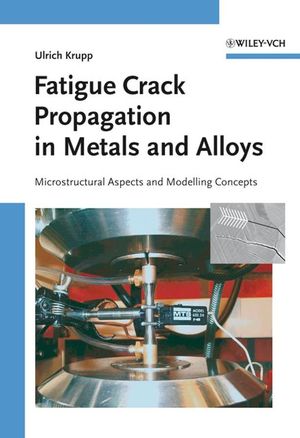Fatigue Crack Propagation in Metals and Alloys: Microstructural Aspects and Modelling ConceptsISBN: 978-3-527-31537-6
Hardcover
311 pages
April 2007
 This is a Print-on-Demand title. It will be printed specifically to fill your order. Please allow an additional 10-15 days delivery time. The book is not returnable.
|
||||||
Foreword vii
Preface ix
Symbols and Abbreviations xv
1 Introduction 1
2 Basic Concepts of Metal Fatigue and Fracture in the Engineering Design Process 3
2.1 Historical Overview 3
2.2 Metal Fatigue, Crack Propagation and Service-Life Prediction: A Brief Introduction 10
2.2.1 Fundamental Terms in Fatigue of Materials 12
2.2.2 Fatigue-Life Prediction: Total-Life and Safe-Life Approach 15
2.2.3 Fatigue-Life Prediction: Damage-Tolerant Approach 19
2.2.4 Methods of Fatigue-Life Prediction at a Glance 24
2.3 Basic Concepts of Technical Fracture Mechanics 25
2.3.1 The K Concept of LEFM 27
2.3.2 Crack-Tip Plasticity: Concepts of Plastic-Zone Size 31
2.3.3 Crack-Tip Plasticity: The J Integral 34
3 Experimental Approaches to Crack Propagation 39
3.1 Mechanical Testing 39
3.1.1 Testing Systems 39
3.1.2 Specimen Geometries 43
3.1.3 Local Strain Measurement: The ISDG Technique 46
3.2 Crack-Propagation Measurements 48
3.2.1 Potential-Drop Concepts and Fracture Mechanics Experiments 49
3.2.2 In Situ Observation of the Crack Length 54
3.3 Methods of Microstructural Analysis and Quantitative Characterization of Grain and Phase Boundaries 56
3.3.1 Analytical SEM: Topography Contrast to Study Fracture Surfaces 56
3.3.2 SEM Imaging by Backscattered Electrons and EBSD 58
3.3.3 Evaluation of Kikuchi Patterns: Automated EBSD 62
3.3.4 Orientation Analysis Using TEM and X-Ray Diffraction 63
3.3.5 Mathematical and Graphical Description of Crystallographic Orientation Relationships 65
3.3.6 Microstructure Characterization by TEM 70
3.3.7 Further Methods to Characterize Mechanical Damage Mechanisms in Materials 72
3.4 Reproducibility of Experimentally Studying the Mechanical Behavior of Materials 74
4 Physical Metallurgy of the Deformation Behavior of Metals and Alloys 75
4.1 Elastic Deformation 76
4.2 Plastic Deformation by Dislocation Motion 80
4.3 Activation of Slip Planes in Single- and Polycrystalline Materials 90
4.4 Special Features of the Cyclic Deformation of Metallic Materials 94
5 Initiation of Microcracks 99
5.1 Crack Initiation: Definition and Significance 99
5.1.1 Influence of Notches, Surface Treatment and Residual Stresses 100
5.2 Influence of Microstructual Factors on the Initiation of Fatigue Cracks 101
5.2.1 Crack Initiation at the Surface: General Remarks 101
5.2.2 Crack Initiation at Inclusions and Pores 102
5.2.3 Crack Initiation at Persistent Slip Bands 104
5.3 Crack Initiation by Elastic Anisotropy 107
5.3.1 Definition and Significance of Elastic Anisotropy 107
5.3.2 Determination of Elastic Constants and Estimation of the Elastic Anisotropy 109
5.3.3 FE Calculations of Elastic Anisotropy Stresses to Predict Crack Initiation Sites 113
5.3.4 Analytical Calculation of Elastic Anisotropy Stresses 116
5.4 Intercrystalline and Transcrystalline Crack Initiation 119
5.4.1 Influence Parameters for Intercrystalline Crack Initiation 119
5.4.2 Crack Initiation at Elevated Temperature and Environmental Effects 123
5.4.3 Transgranular Crack Initiation 126
5.5 Microstructurally Short Cracks and the Fatigue Limit 127
5.6 Crack Initiation in Inhomogeneous Materials: Cellular Metals 129
6 Crack Propagation: Microstructural Aspects 135
6.1 Special Features of the Propagation of Microstructurally Short Fatigue Cracks 135
6.1.1 Definition of Short and Long Cracks 136
6.2 Transgranular Crack Propagation 139
6.2.1 Crystallographic Crack Propagation: Interactions with Grain Boundaries 139
6.2.2 Mode I Crack Propagation Governed by Cyclic Crack-Tip Blunting 145
6.2.3 Influence of Grain Size, Second Phases and Precipitates on the Propagation Behavior of Microstructurally Short Fatigue Cracks 149
6.3 Significance of Crack-Closure Effects and Overloads 153
6.3.1 General Idea of Crack Closure During Fatigue-Crack Propagation 153
6.3.2 Plasticity-Induced Crack Closure 156
6.3.3 Influence of Overloads in Plasticity-Induced Crack Closure 160
6.3.4 Roughness-Induced Crack Closure 161
6.3.5 Oxide- and Transformation-Induced Crack Closure 162
6.3.6 ΔK*/K* max Thresholds: An Alternative to the Crack-Closure Concept 163
6.3.7 Development of Crack Closure in the Short Crack Regime 164
6.4 Short and Long Fatigue Cracks: The Transition from Mode II to Mode I Crack Propagation 171
6.4.1 Development of the Crack Aspect Ratio a/c 173
6.4.2 Coalescence of Short Cracks 179
6.5 Intercrystalline Crack Propagation at Elevated Temperatures: The Mechanism of Dynamic Embrittlement 181
6.5.1 Environmentally Assisted Intercrystalline Crack Propagation in Nickel-Based Superalloys: Possible Mechanisms 181
6.5.2 Mechanism of Dynamic Embrittlement as a Generic Phenomenon: Examples 187
6.5.3 Oxygen-Induced Intercrystalline Crack Propagation: Dynamic Embrittlement of Alloy 718 192
6.5.4 Increasing the Resistance to Intercrystalline Crack Propagation by Dynamic Embrittlement: Grain-Boundary Engineering 197
7 Modeling Crack Propagation Accounting for Microstructural Features 207
7.1 General Strategies of Fatigue Life Assessment 207
7.2 Modeling of Short-Crack Propagation 211
7.2.1 Short-Crack Models: An Overview 211
7.2.2 Model of Navarro and de los Rios 218
7.3 Numerical Modeling of Short-Crack Propagation by Means of a Boundary Element Approach 226
7.3.1 Basic Modeling Concept 226
7.3.2 Slip Transmission in Polycrystalline Microstructures 230
7.3.3 Simulation of Microcrack Propagation in Synthetic Polycrystalline Microstructures 232
7.3.4 Transition from Mode II to Mode I Crack Propagation 236
7.3.5 Future Aspects of Applying the Boundary Element Method to Short-Fatigue-Crack Propagation 239
7.4 Modeling Dwell-Time Cracking: A Grain-Boundary Diffusion Approach 242
8 Concluding Remarks 251
References 255
Subject Index 281



